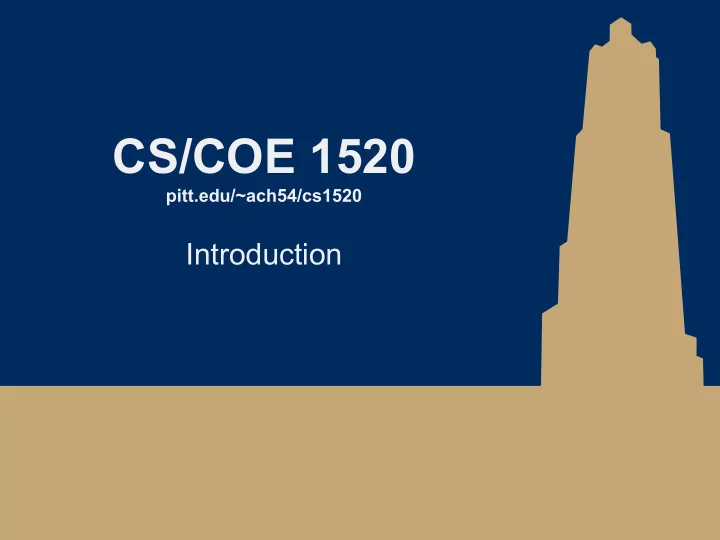

CS/COE 1520 pitt.edu/~ach54/cs1520 Introduction
Meta-notes ● These notes are intended for use by students in CS1520 at the University of Pittsburgh. They are provided free of charge and may not be sold in any shape or form. ● These notes are NOT a substitute for material covered during course lectures. If you miss a lecture, you should definitely obtain both these notes and notes written by a student who attended the lecture. 2
Instructor Info ● Adam Hobaugh (A.C.Hobaugh@pitt.edu) Office: 6211 Sennott Square ● All other info appears on the class website ○ E.g., office hours, TA contact info/office hours 3
A note about email ● Prefix all email subjects with [CS1520] ● There are two people named Adam Hobaugh at Pitt ○ If emailing me from Outlook/Office365, make sure to choose “Hobaugh, Adam Christopher” in the To field 4
Course Info ● Website: ○ pitt.edu/~ach54/cs1520/ Review the Course Information and Policies ● 5
Programming languages for web applications ● Goals for the course: Examine the functionality of several different ○ programming languages to gain a better understanding of the study of programming languages, themselves ○ Learn the basics of and current practices for developing web applications 6
The World Wide Web "a part of the Internet accessed through a graphical user TERRIBLE interface and containing documents often connected by DEFINITION hyperlinks —called also Web" 7
The World Wide Web "The World Wide Web (WWW) is an information space where documents and other web resources are identified by URLs, interlinked by hypertext links, and can be accessed via the Internet" 8
History of the web ● 1945: Vannevar Bush proposed the "memex", a device for storing and linking information stored on mircrofilm ● 1963: Ted Nelson coined the term "hypertext" as a text approach breaking away from traditional linear limitations ● Sir Tim Berners-Lee ○ 1980: proposed ENQUIRE as a hypertext documentation system for CERN in Switzerland ○ 1989: proposed implementing a hypermedia system on top of the Internet, inventing the Web ○ 1990: wrote the first web browser (called WorldWideWeb) 9
10
Hypertext 11
HTML ● Web documents are commonly formatted and annotated using the HyperText Markup Language ○ First references to HTML made by Sir Tim in 1991 ○ First real standard proposed in 1995 with HTML 2.0 ○ Current version is HTML5 ● HTML documents are built out of HTML elements ○ Elements are delineated by tags 12
Intro to HTML ● HTML5 documents have the following basic shell: <!DOCTYPE html> <html> <head> </head> <body> </body> </html> 13
HTML tag basics ● Most tags are pairs, start and end tags: ○ <p> This text would be considered a paragraph </p> ○ <em> This text would be emphasized </em> ● Comments have their own start and end tags: ○ <!-- This is an HTML comment --> ○ <!-- Multiline comment --> ● There are also self closing tags ○ <br> <!-- The br tag inputs a line break --> ● Tags also have attributes ○ <a href="http://example.com">click here!</a> 14
id and class attributes ● id allows you to target a specific instance of an element ○ <!-- ids should be unique on a page --> <span id="A"></span> <span id="B"></span> <span id="B"></span> ● class allows you to target a group of elements ○ <!-- classes can repeat --> <span id="A" class="custom"></span> <span id="B" class="custom"></span> <div class="custom"></div> 15
Modern use of HTML ● HTML is used to present the structure of a document ○ What text that should be displayed ○ What images or other media that should be displayed ● It is often used in conjunction with Cascading Style Sheets (CSS), which describe the presentation of the document ○ Colors, fonts, positioning, etc. ● Italics example: ○ <span class="italics">this will be italicized</span> ○ span.italics {font-style: italic;} … Emphasis tag ( <em></em> ) normally displays in italics ● ○ Difference? 16
Italicized emphasis isn't the only default style ● Browsers have default stylings for many elements that can be overridden 17
CSS Selectors ● CSS target examples: ○ HTML elements ■ span { color: red; } ○ Specific ids ■ #unique { color: blue; } ○ Specific classes ■ .custom { color: green; } ○ Combinations ■ span#unique { color: yellow; } 18
Tentative Syllabus ● Responsive Design JavaScript ● Interpreted languages ● The DOM Python ● Web Storage ● Regular Expressions ● Networking Overview ● Python ● The Flask Microframework ● AJAX ● REST ● Functional Programming ● ECMAScript ● Web Security 19
Recommend
More recommend